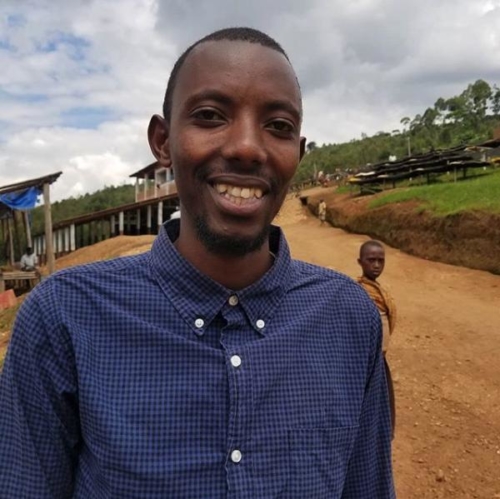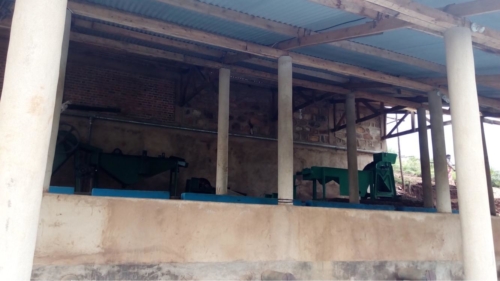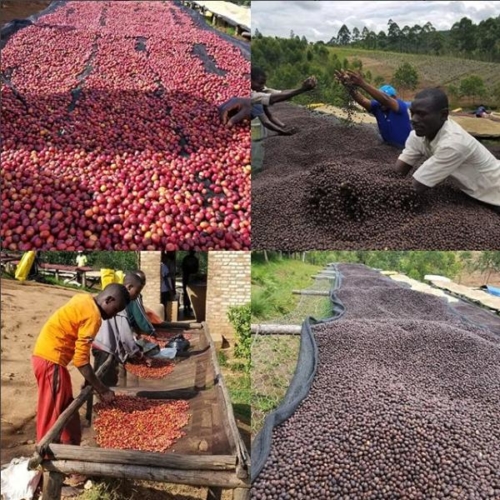Description
Burundi
Kayanza
1800 METERS
Washed
Red Bourbon

Salum Ramadhan

Blackberry, Passion Fruit, Black Cherry
Filter, Espresso, Mokapot, Turkish
This coffee coming from Shembati washing station is interesting because of the way that the washing station is operating, the team here is very dedicated to producing and processing coffee so that it can be the best it possibly can be in the cup.
If you’re looking for more fruit in your cup we can recommend this coffee, we found this to be packed full of fruits from watermelon to sour cherries, it’s wild!
Origin: Shembati Washing Station
Shembati smallholders
Shembati Washing Station is one of two washing stations built in 2016 by the producer Salum Ramadhan. Its located in the province of Kayanza in the hills of Butaganzwa commune. The site manager is a young guy called Ame Patrick. Its a medium sized washing station and they receive about 700 tons of cherry pr season. That adds up to about 5 containers of specialty. They have a clean natural water source. There is about 200 drying tables and many of them have a 2 stories, meaning the coffees will partially be dried in shade. Salum is now also specialized in producing naturals and honeys as well as regular washed and all he’s 4 washing stations.
Although he has been working with smallholders in the Shembati area for some years now, the government changed the laws to limit the area washing stations can receive or accept cherry from, hence he built this washing station to be able to continue to work with the smallholders in this area. Our history with Salum dates back to 2011, and the relationship has worked out great since then. He’s extremely detail oriented, spends a lot of time to train local staff and have a great loyal workforce. He’s also having a transport business and it is through that, managing the domestic coffee logistics as well for us. This means that we are always getting our coffees out quickly while they are still fresh.
He is systematically separating the coffees based on where they are grown, and by the date of processing. Post harvest we are cupping through some hundred samples to select the ones we find outstanding. They generally collect cherries from within a community, however the landscape in Burundi means the communities are situated in between hills and this can often create microclimates specific to each area.
He’s also investing in social and environmental projects such as education in the local areas, ponds for wastewater etc.
Picking and selection
The main harvest will normally start very slowly in March, peak around May (depending on altitude and weather) and end in July. The family members on the small farms are working the land, picking the coffee cherries themselves in the afternoon or on Saturdays. They will then either deliver the cherries to Shembati washing station by foot or bicycle, Salum can still pick up cherry with his truck but only when the farmer is within the newly regulated radius from the washing station.The farmers are free to deliver their cherries to anyone offering the highest price. And the competition in this area can be hard. Salum and his team will communicate with the local farmers on selective picking and sorting. To attract farmers with the best qualities they are constantly paying premiums above the market prices to improve the product.
Cherry reception
Bringing in cherries from the different collection points is expensive as the cost of transport in Burundi is high. Still, it has been good for quality as he have well trained staff, good capacity and infrastructure to produce micro lots.
Shembati washing station has strict routines for cherry reception. The coffees are sorted by the farmers at the receiving stations on raised tables, or they even have small flotation tank system for each farmer at delivery. They also have workers dedicated to sort out un ripe and over ripe coffees for their special preparation of micro lots. The pre processing flotation process is to first put the cherries in water tanks. They will then skim off the floaters and give it back to the farmer before the coffees are hand sorted to separate out unripe/half-ripe.
Fermentation, washing and drying
The elevation at the washingstation is high, and climate is cool, meaning it’s easier to control the fermentation time. The traditional fermentation and washing process in Burundi is a lengthy procedure with double fermentation (dry and wet fermentation) before soaking. The double fermentation is a labor intensive process that also requires a lot of water, and creates more wastewater. They changed the process to reduce water usage, labor, increase capacity and avoid over fermentation.
They generally do a 12 hour dry fermentation. It’s then graded in washing channels in to 3-4 grades based on density before 12-18 hours soaking time in clean water.
From there it goes to pre drying under shade with handpicking of wet parchment before entering the elevated and sun exposed drying tables. Drying normally takes 15 – 20 days depending on the climate and rainfall. It’s not uncommon with rain during the drying, and they have to be quick to cover up the parchment when they see the clouds are building up.
Honey Process
They are only targeting the highest qualities for their honey process as it is relatively complicated in their climate, specially during the beginning of the harvesting season when there is a lot of rain.
The cherries are going through separation by soaking and are hand sorted before it goes in to production. After sorting the coffees are de pulped before they get graded by density in the channels of the traditional Agarde disc pulper. It’s graded in to 3 grades by density where only the first grades from the denser beans goes to Honey production. After pulping and grading they still have all the mucilage left. This would be referred to as black honey in e.g. Costa Rica.
They get spread out in a medium thick layer in under shade the first 1-2 days. Later they move it out in the sun, but make sure its dried carefully. They get covered up by night. After the first days they start to move the «sticky» parchment and crack it up so that every single bean is not sticking to another bean. Its dried about 20 days in sun on raised beds. They are sorting the defects during the drying period.
Natural process
They have gotten really good experience with their naturals the past few years. And its been improved a lot. They are generally making naturals when they have great cherry quality coming in and when they have enough capacity on the tables to do it properly. The cherries are soaked in water to remove all floaters. They spread it out in a single layer about the first 2 days while they are sorting out immature, deceased and overripe cherries. Its also to get it dried faster in the beginning of the drying cycle as that seems to create a cleaner and brighter profile in their environment. After the 2 – 3 first days they slowly build up the layers, and are moving and turning the cherries on the table multiple times pr day.


















Reviews
There are no reviews yet.